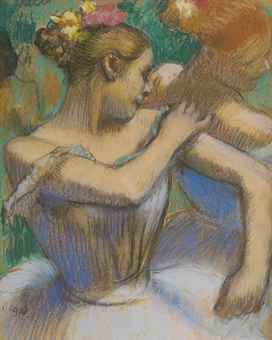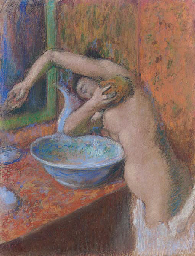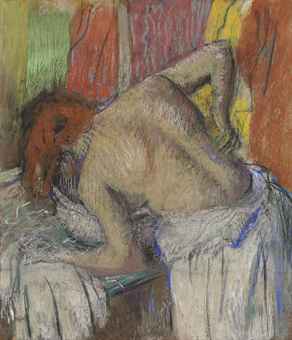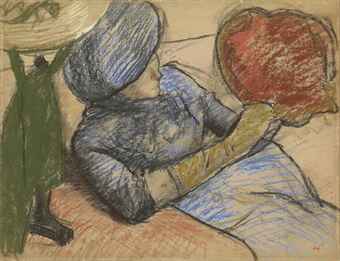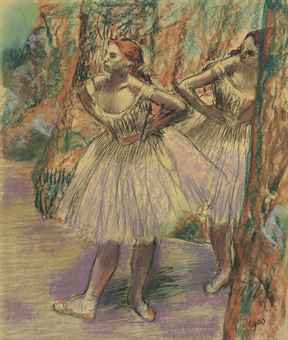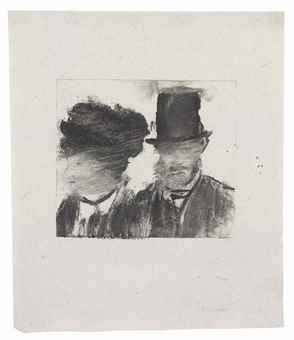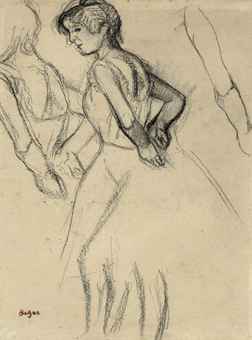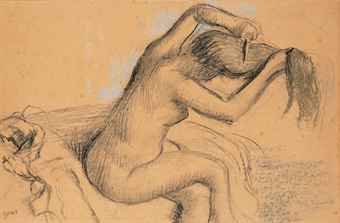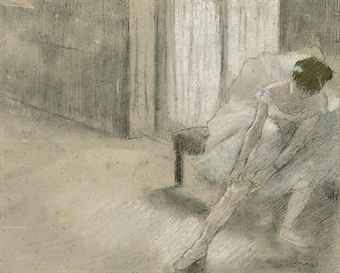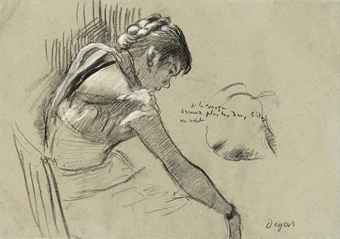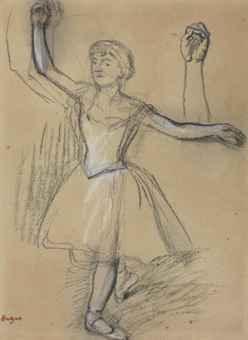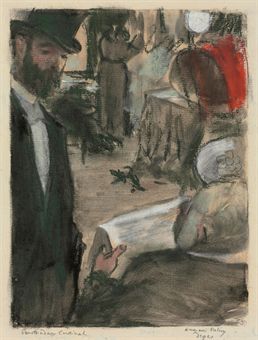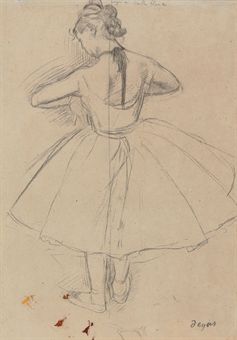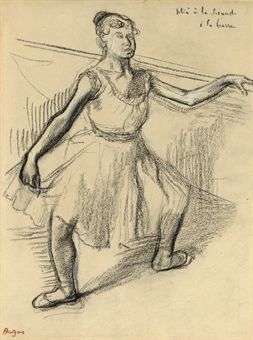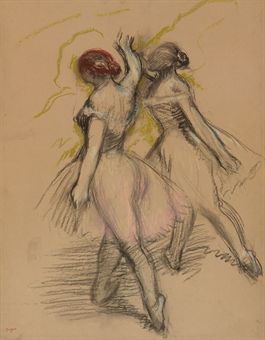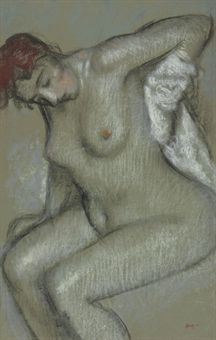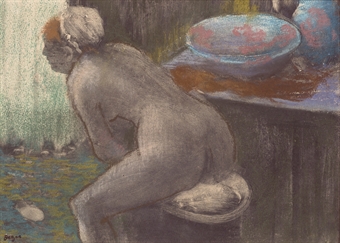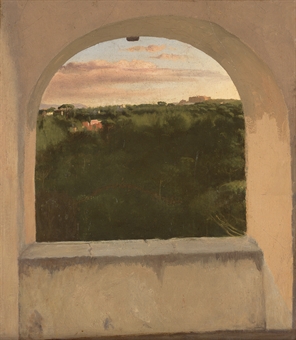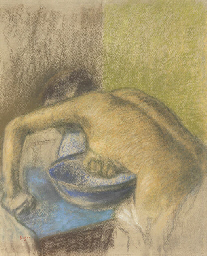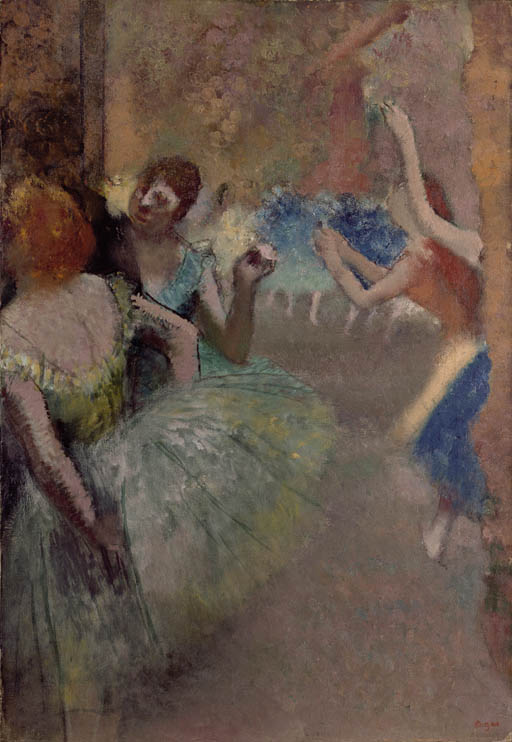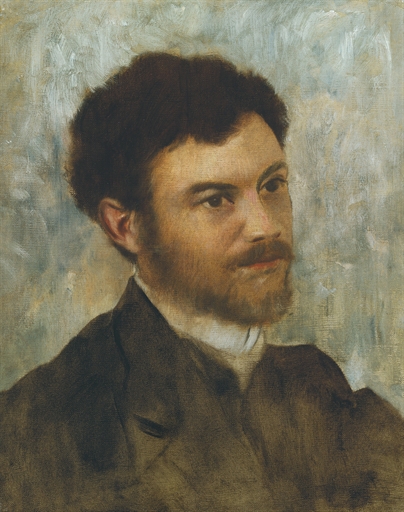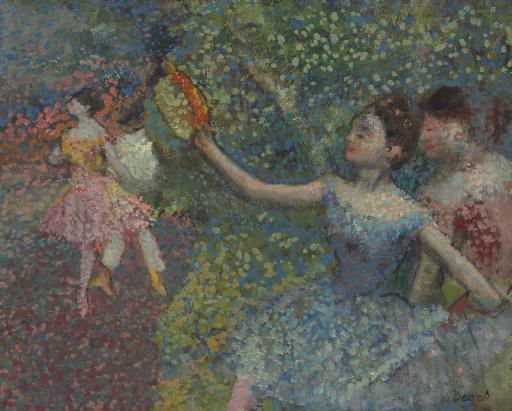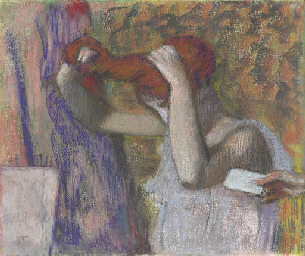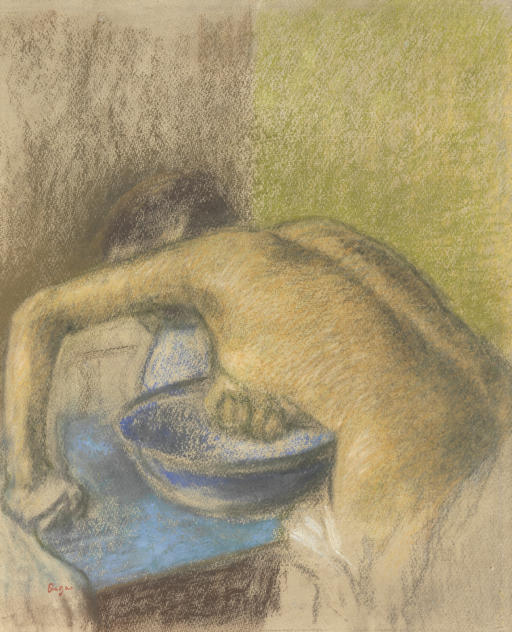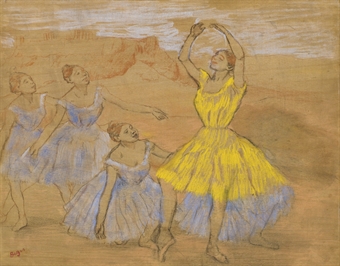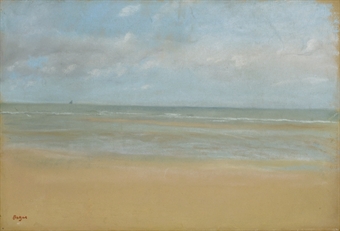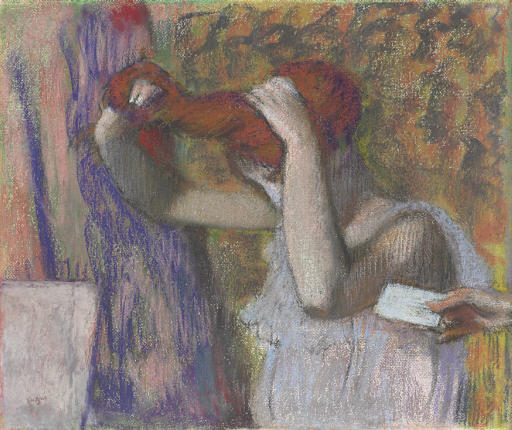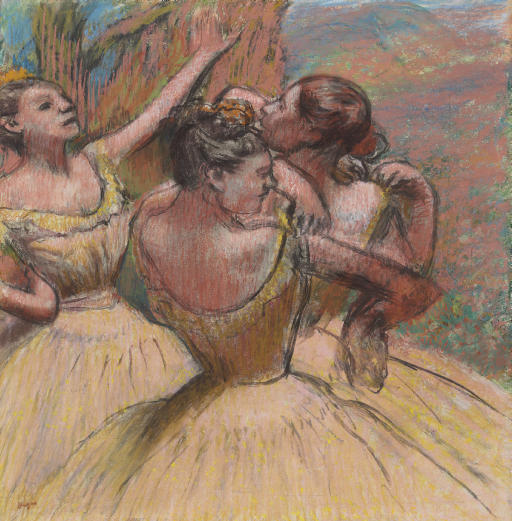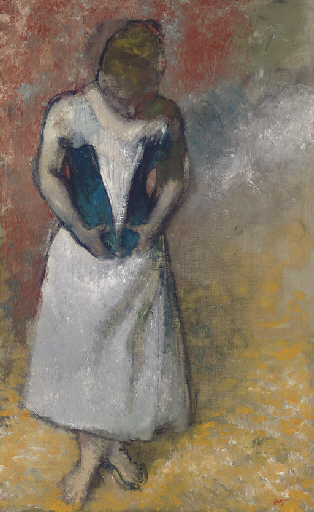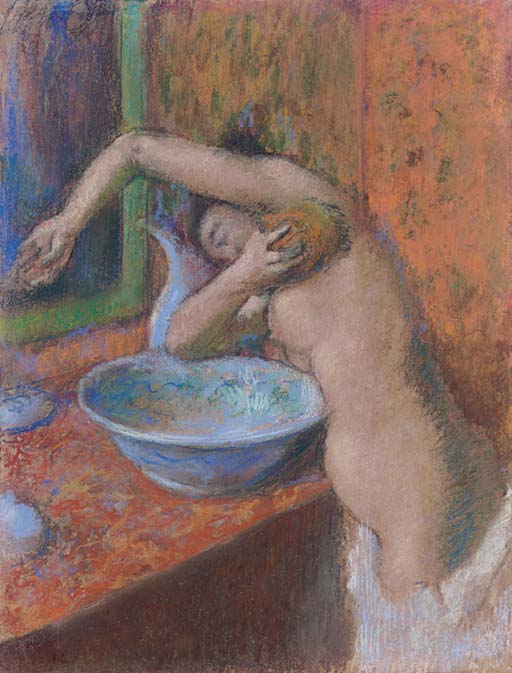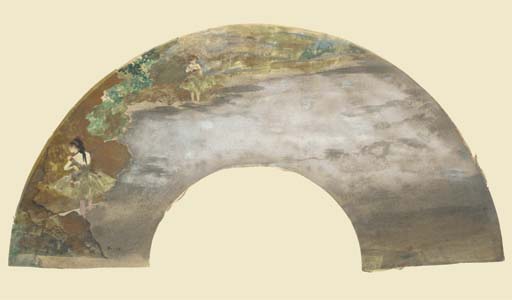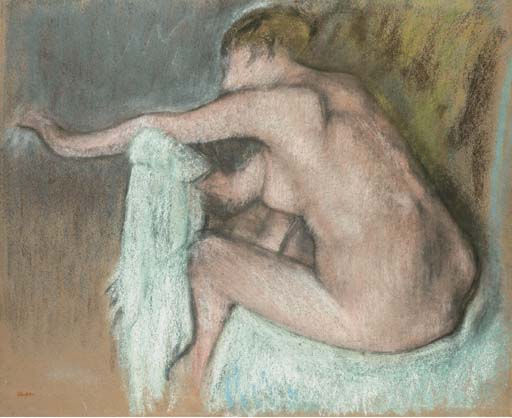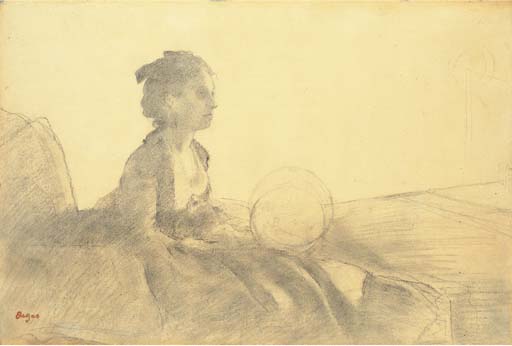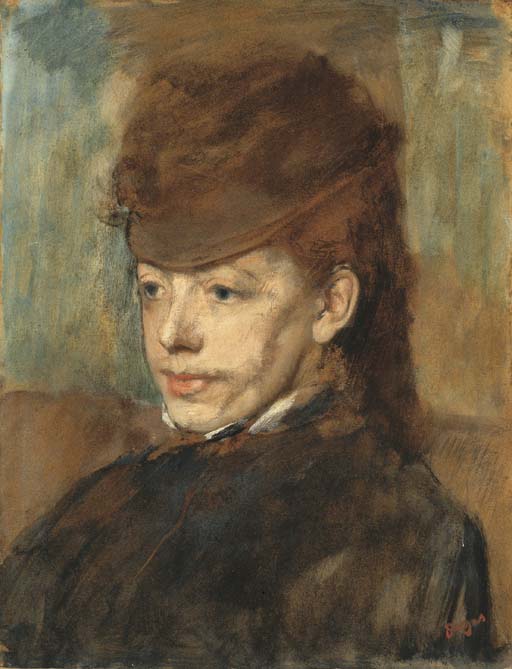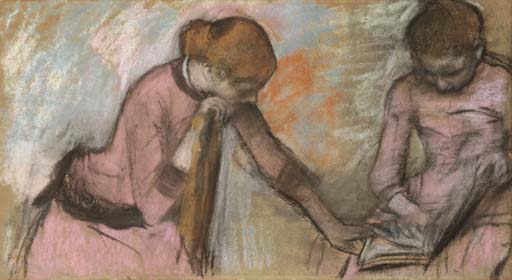Sotheby’s London Impressionist & Modern Evening Sale 3rd February 2015
Edgar Degas, Quatre Danseuses, est. £3 – 5 million / $4.6 – 7.7 million
Executed shortly after the turn of the century, Edgar Degas’ highly expressive Quatre Danseuses depicts one of the artist’s favourite subjects – ballet dancers preparing for a performance. Throughout his career, Degas’ treatment of this subject underwent a radical metamorphosis, and in his later years he developed a highly expressive use of materials. In Quatre Danseuses the artist’s vibrant markings, applied in coat after coat of coloured chalk, achieve an effect that appears to be painted. By the end of his career Degas had become a modern artist whose expressive techniques influenced many more of the greatest colourists that followed.
Sotheby’s London Sales of Impressionist
and Modern Art on 5 & 6 February 2014
The collection is also distinguished by masterful Impressionist works,
including a sublime pastel by Edgar Degas depicting a woman at her toilette – a
theme central to the artist’s oeuvre that underlines his mastery of
pastel.Dating from circa1893,
Femme
s’essuyant les pieds is a work of genius in its subtlety of line and the
boldness of its composition (est. est. £1-1.5 million/$1.5-2 million)
Sotheby’s 4 November 2009
One of Edgar Degas’ finest racing
pictures, Avant la course, painted
circa1882-88 will also be offered (est. $4/6 million). The artist’s exploration
of the world of the racetrack and steeplechase developed in tandem with his
survey of other aspects of the modern world, notably the world of dance. In his
depictions of equestrian subjects, Degas moved from the precise delineation of
complex arrangements of figures in space in the first half of his career to a
much broader, more atmospheric approach in the latter half, when the present
work was executed. Avant la course is
composed of flat modernist patches of color in which the artist employed great
contrasts of light and dark forms and asserted the dynamism of the composition
over any specificity of details.
Bonhams 2014
Bonhams Impressionist & Modern Art auction
on 3 February 2015
Edgar Degas' 1885 oil on canvas, Scène de
ballet, is to be offered at the Impressionist & Modern Art auction
on 3 February 2015 at Bonhams New Bond Street. The work, a wonderful
example of Degas' ground-breaking work in the mid-1880s, is estimated at
£2,500,000-3,500,000.
Degas' fascination with the dancers of the Paris Opéra was the source of more than 1,000 paintings, pastels, charcoal drawings and prints, which together earned the artist the reputation as the greatest painter of the Paris ballet. He obsessively readdressed the subject, using it to explore a number of revolutionary styles and innovative techniques.
In Scène de ballet, Degas depicts not only the row of on-stage dancers in the background, but also the girls off-stage, stretching and chatting in the foreground. The artist sought to cover all aspects of the ballet, from the initial rehearsals and preparations through to the bright lights and thrilling spectacle of the final performance.
The ballet became for Degas a lens through which he could experiment with light, color and movement, all the while observing and documenting the contemporary social milieu. Performances brought together the social classes, providing a cross section of society, and Degas depicted the drawn, tired faces of the dancers, who usually came from the most impoverished area of the city, alongside the affluent and predatory abonnés (season-ticket holders) who hung around backstage to proposition the girls.
As such, a behind-the-curtain image such as Scène de ballet shares something of the social commentary of Degas' earlier paintings of café culture and brothels which established his fame. But this similarity of subject belies the significant difference between this 1885 painting and those which went before.
The mid-1880s was a crucial few years in Degas' development. Previously, the artist had been working in a tight, precise style founded on exquisite draftsmanship. From around 1885, however, he developed a new style of which Scène de ballet is a prime example – looser, brighter, and more abstracted in form.
Works such as Scène de ballet represent a turning point for Degas. The skirts, faces and bodies of the dancers are conjured from clouds of pigment, while the stage-set background is created using layer upon layer of paint applied directly with the artist's thumbs. We see, too, the beginnings of the bursting vibrancy – ultramarines, turquoises, russets, cardamom reds, roses pinks and flashes of brightest yellows – for which his late bathers and dancers were so celebrated.
Only a year after Degas painted Scène de ballet, he took part in his final Impressionist group show, and began his withdrawal from the public art world. But his experimentation with the possibilities of color and form continued until his death in 1917, culminating in the staggeringly modern late works which 20th-century masters such as Picasso and Matisse found so inspiring.
India Phillips, Director and Head of the Impressionist & Modern Art Department at Bonhams, said: 'Degas is the painter of the ballet. No other artist has captured the movements, costumes and spectacle of the dance in the same way. Scène de ballet is as iconic an image as you could hope for, and we are honored to be offering it for sale.'
Degas' fascination with the dancers of the Paris Opéra was the source of more than 1,000 paintings, pastels, charcoal drawings and prints, which together earned the artist the reputation as the greatest painter of the Paris ballet. He obsessively readdressed the subject, using it to explore a number of revolutionary styles and innovative techniques.
In Scène de ballet, Degas depicts not only the row of on-stage dancers in the background, but also the girls off-stage, stretching and chatting in the foreground. The artist sought to cover all aspects of the ballet, from the initial rehearsals and preparations through to the bright lights and thrilling spectacle of the final performance.
The ballet became for Degas a lens through which he could experiment with light, color and movement, all the while observing and documenting the contemporary social milieu. Performances brought together the social classes, providing a cross section of society, and Degas depicted the drawn, tired faces of the dancers, who usually came from the most impoverished area of the city, alongside the affluent and predatory abonnés (season-ticket holders) who hung around backstage to proposition the girls.
As such, a behind-the-curtain image such as Scène de ballet shares something of the social commentary of Degas' earlier paintings of café culture and brothels which established his fame. But this similarity of subject belies the significant difference between this 1885 painting and those which went before.
The mid-1880s was a crucial few years in Degas' development. Previously, the artist had been working in a tight, precise style founded on exquisite draftsmanship. From around 1885, however, he developed a new style of which Scène de ballet is a prime example – looser, brighter, and more abstracted in form.
Works such as Scène de ballet represent a turning point for Degas. The skirts, faces and bodies of the dancers are conjured from clouds of pigment, while the stage-set background is created using layer upon layer of paint applied directly with the artist's thumbs. We see, too, the beginnings of the bursting vibrancy – ultramarines, turquoises, russets, cardamom reds, roses pinks and flashes of brightest yellows – for which his late bathers and dancers were so celebrated.
Only a year after Degas painted Scène de ballet, he took part in his final Impressionist group show, and began his withdrawal from the public art world. But his experimentation with the possibilities of color and form continued until his death in 1917, culminating in the staggeringly modern late works which 20th-century masters such as Picasso and Matisse found so inspiring.
India Phillips, Director and Head of the Impressionist & Modern Art Department at Bonhams, said: 'Degas is the painter of the ballet. No other artist has captured the movements, costumes and spectacle of the dance in the same way. Scène de ballet is as iconic an image as you could hope for, and we are honored to be offering it for sale.'
EDGAR DEGAS
(1834-1917)
Danseuses et contrebasse
9 x 6 3/4 in (23.2 x 17 cm)
Sold for
US$ 485,000
Edgar Degas
DEUX DANSEUSES ASSISES
LOT SOLD.
5,205,000 USD
Edgar Degas
DEUX DANSEUSES AU FOYER
LOT SOLD.
506,500 GBP
Edgar Degas
LA CONVERSATION
Estimate 3,500,000
—
5,000,000
USD
Edgar Degas
DEUX ÉTUDES POUR DANSEUSES
LOT SOLD.
1,426,500 GBP Edgar Degas
CHEVAL GALOPANT
LOT SOLD.
100,000 USD
Edgar Degas
AU SALON (CES DAMES)
LOT SOLD.
20,000 GBPEdgar Degas
DEUX ÉTUDES DE CAVALIER
LOT SOLD.
57,500 GBP
Edgar Degas
JOCKEY BLESSÉ
LOT SOLD.
45,000 GBP
Sotheby’s 2013
Edgar Degas
DANSEUSE RAJUSTANT SON CHAUSSON
LOT SOLD.
4,521,250 GBP
Edgar Degas
APRÈS LE BAIN (FEMME S'ESSUYANT)
LOT SOLD.
7,769,250 GBP
Edgar Degas
FEMMES AU BAIN
Edgar Degas
FEMME SE PEIGNANT
LOT SOLD.
1,085,000 USD
Edgar Degas
AUTOPORTRAIT
Estimate
1,200,000
—
1,800,000
Sotheby’s 2010
Edgar Degas
FEMME S'ESSUYANT APRÈS LE BAIN
LOT SOLD.
992,500 USD
Edgar Degas
FEMME SE COIFFANT
Estimate 3,000,000
—
4,000,000 USD
Christie's
Danseuses à la barre
PRICE REALIZED
£13,481,250
Danseuses
PRICE REALIZED
$10,722,500
Danseuses jupes jaunes (Deux danseuses en jaune)
PRICE REALIZED
£5,417,250
Trois danseuses (Jupes jaunes, corsages bleus)
PRICE REALIZED
£3,961,250
Après le bain, femme s'essuyant
PRICE REALIZED
$5,906,500
Trois danseuses
PRICE REALIZED
$4,297,000
Danseuse rajustant ses épaulettes
PRICE REALIZED
£2,281,250
Femme à sa toilette
PRICE REALIZED
£1,700,000
Femme s'épongeant le dos
PRICE REALIZED
$3,218,500
Christie's 2014
Christie's 2014
Christie's 2009
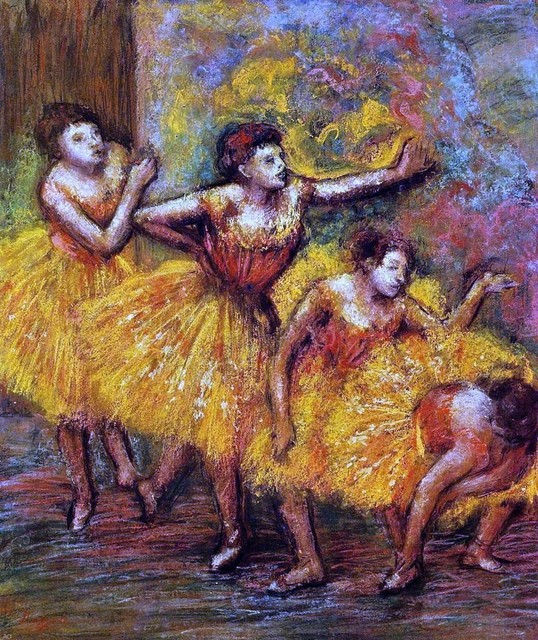

.jpg)

















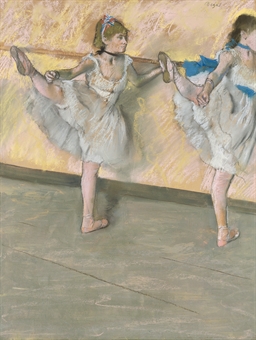
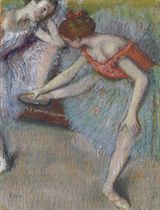

.jpg)

